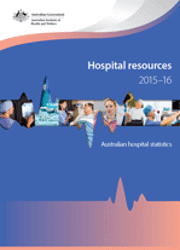Summary
In 2015–16, there were 701 public hospitals in Australia, with 61,000 beds. Public hospitals were very diverse, with 69% having fewer than 50 beds, and 30 principal referral hospitals in metropolitan areas having an average of 659 beds. There were 630 private hospitals with 33,100 hospital beds (including day hospital facilities).
Between 2011–12 and 2015–16, the number of available beds in public hospitals rose by 1.0% on average each year, while the number of beds per 1,000 population remained relatively stable. Same-day beds accounted for an increasing proportion of public hospital beds, rising from 12.0% in 2011–12 to 12.6% in 2015–16.
Between 2011–12 and 2015–16, the number of licensed beds in private hospitals rose by 3.3% on average each year.
Australia had a total of 4.0 beds per 1,000 population in public hospitals and private hospitals, compared with an average of 4.8 beds per 1,000 for OECD countries and other selected countries.
What specialised service units were provided by public hospitals?
Public hospitals provide a range of specialised units that deliver specific types of services for admitted and non-admitted patients.
In 2015–16, the most common specialised service provided was domiciliary care (home-based care, provided by 373 hospitals), followed by nursing home care (285 hospitals). There were 83 intensive care units (level III and above) and 27 neonatal intensive care units (level III and above).
How were hospitals funded?
In 2014–15, public hospitals were mainly funded by the Australian (38%) and state or territory (53%) governments, and about 9% of funding was from non-government sources. In contrast, about 67% of private hospital funding came from non-government sources.
Between 2010–11 and 2014–15, funding for public hospitals rose by 4.7% on average each year (after adjusting for inflation), from $40 billion to $48 billion. Funding for private hospitals rose by 7.1% on average each year, from $11 billion to $14 billion. Comprehensive funding information for 2015–16 is not yet available.
How much did hospitals spend?
In 2015–16, total recurrent expenditure on public hospital services was about $64 billion (including depreciation). About 57% of this amount was for admitted patient care, 18% for outpatient care, 10% for emergency care services and 2% for teaching, training and research. Recurrent expenditure for private hospitals was more than $13 billion in 2015–16.
How many people were employed in public and private hospitals?
Nationally, 360,000 full-time equivalent staff were employed in providing public hospital services in 2015–16. About 41% of staff were Nurses (149,000) and 12% were Salaried medical officers (45,000).
Between 2011–12 and 2015–16, average salaries for nurses and salaried medical officers in public hospitals increased by 1.9% and 1.5% on average each year, respectively.
There were 66,800 staff employed in private hospitals in 2015–16. Nurses accounted for about 56% of them.
Preliminary material: Acknowledgments; Abbreviations; Symbols
1 Introduction
- What’s in this report?
- What data are reported?
- What are the limitations of the data?
- What methods are used?
2 How many hospitals are there in Australia?
- Key findings
- How many hospitals were there?
- How many hospital beds were there?
- How many Local hospital networks were there in 2015–16?
3 How diverse were public hospitals?
- Key findings
- How did public hospitals differ?
- How did public hospitals differ in size?
- What specialised service units did public hospitals provide?
- How many specialised admitted patient clinical units were there in 2015–16?
4 Who funded hospitals and how much did hospitals spend?
- Key findings
- How were hospitals funded?
- Commonwealth funding arrangements
- How much recurrent expenditure was reported?
- How much was spent on different types of care in public hospitals?
5 How many people were employed?
- Key findings
- How many staff provided public hospital services?
- What was the average salary for staff providing public hospital services?
- How many staff worked in private hospitals?
Appendixes
Appendix A: Database quality statement summary
Appendix B: Technical notes
Appendix C: Public hospital peer groups
Appendix D: Service Related Groups
Appendix E: Public hospital accreditation information
End matter: Glossary; References; List of tables; List of figures; List of boxes; Related publications



